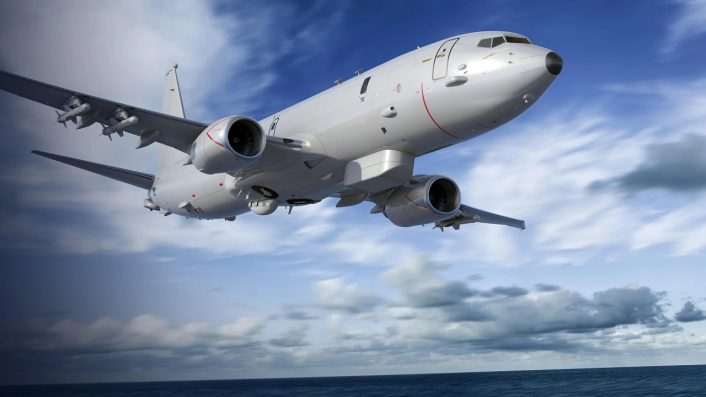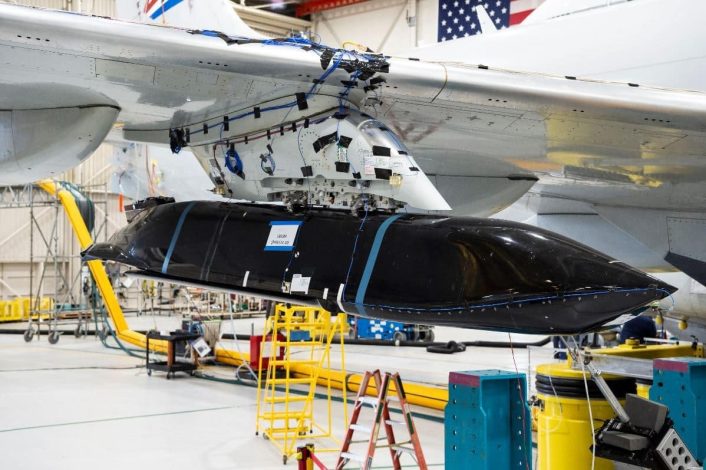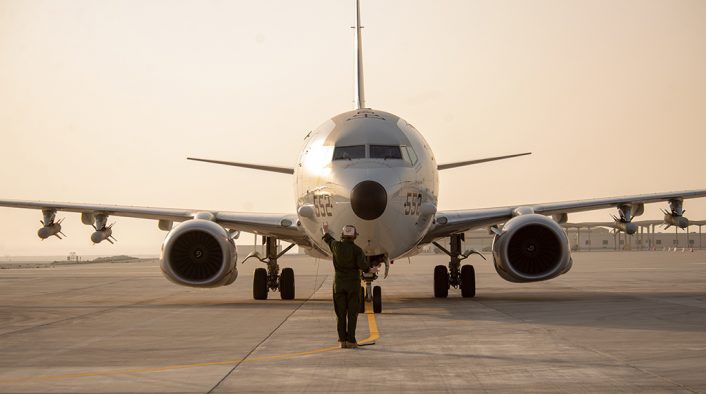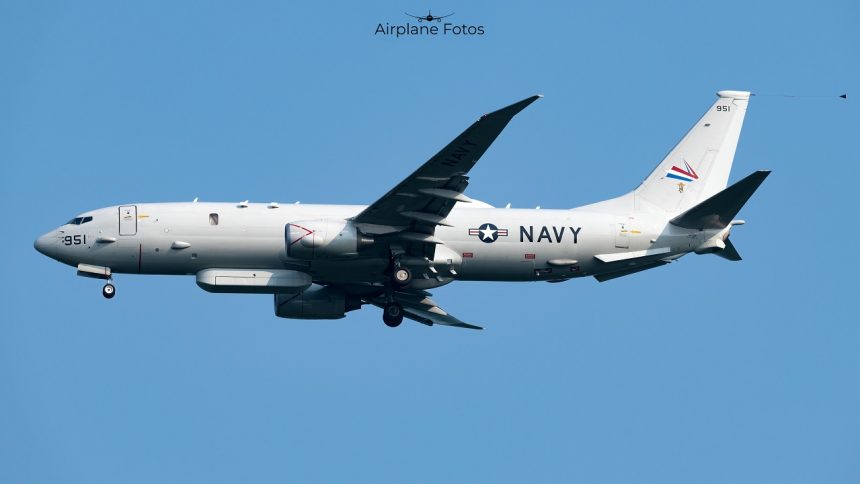The MMP, currently being tested on the P-8, was internally funded by Boeing and is intended to carry sensors that are not organic to the Poseidon.
We might have got the first ever look at the new Multi-Mission Pod (MMP) for the P-8A Poseidon Maritime Patrol Aircraft (MPA). The photo, sent to us by aviation photographer Connor Ochs at Airplane Fotos, shows a Poseidon assigned to Air Test and Evaluation Squadron (VX) 20 with the new MMP installed under its centerline attachment point.
The aircraft, according to the ADS-B data, has been flying regularly from Naval Air Station Patuxent River, Maryland, the home station of VX-20. Boeing has recently detailed the ongoing testing of new capabilities on the Poseidon, including the Long Range Anti-Ship Missile (LRASM) and the MPP.
The Multi-Mission Pod
The MMP was first announced in 2016, when Boeing said it was developing the new pod with internal funds. The company at the time said a prototype of the pod was built and used for two flight tests, with results defined as promising.
The pod was first showcased at the Dubai Airshow 2021, where the company shown a rendering and provided more details. Boeing said the MMP is designed to house a wide range of sensors and mission systems, including potential multiple configurations of equipment provided by operator nations.
“Customers might want to do signal or communications intelligence or different kinds of intelligence, surveillance and reconnaissance missions, and have their own functions or their own mechanisms to do that using their own capability within country,” said in that occasion Perry Yaw, Boeing’s leader of P-8 global sales and marketing.
The pod was developed with the same digital design tools used for the T-7 Red Hawk advanced trainer, said Boeing, and intended to attach to existing attachment, power and cooling access points already provided for the APS-154 Advanced Airborne Sensor (AAS) radar. Wind tunnel testing was said to indicate only a negligible drag increase with the pod installed.

A year later, at the Singapore Air Show 2022, Boeing provided some new details, mentioning the MMP is a 20 ft.-long module, designed to accept modular payloads. The company also said the pod can offer larger apertures for sensors, compared to the ones on the aircraft, providing advantages for a “variety of multi-sensor, multi-spectral, multi-intelligent capabilities” that can be housed in the pod.
This year, at the end of June, Boeing confirmed that it has built a MMP and was scheduled to begin testing on the P-8A in July, with certification expected by the end of summer. The company noted that the U.S. Navy awarded a contract to integrate the pod on the Poseidon in September 2023.
“The multimission pod is something that Boeing has been developing for several years,” said Jon Spore, business development manager for P-8 programs. “And to enhance capability in the aircraft, the multimission pod is designed to carry sensors that are not organic to the P-8.
The current payload of the pod is unknown, although Boeing said “any sensor that fits within the size, weight, power, and cooling parameters of the MMP are potential candidates for integration with the MMP and aircraft.”
LRASM testing
Boeing also provided updates on the integration of the LRASM weapon on the P-8A, saying the activities should be completed by this summer. “The testing is currently going well. We expect it to be done later this summer if all things continue as planned. And that’ll be yet another capability that the US Navy will have at its disposal,” said Spore.
The aircraft, once the integration is complete, will be able to carry four LRASMs on its under-wing pylons. The Navy did not provide further details but released a photo of the weapon during a fit test on the Poseidon.
The AGM-158C LRASM, based on the AGM-158B Joint Air-to-Surface Standoff Missile – Extended Range (JASSM-ER), is the new low-observable anti-ship cruise missile developed by DARPA (Defense Advanced Research Projects Agency) for the U.S. Air Force and U.S. Navy.

NAVAIR describes the weapon as a defined near-term solution for the Offensive Anti-Surface Warfare (OASuW) air-launch capability gap that will provide flexible, long-range, advanced, anti-surface capability against high-threat maritime targets.
There are currently three variants which comprise the OASuW Increment 1 program, designated LRASM 1.0, LRASM 1.1, and LRASM C-3. The LRASM 1.0 variant, which was fielded with early operational capability in 2019, has already been integrated on the B-1B Lancer and F/A-18E/F Super Hornet.
The newer LRASM 1.1 variant was fielded last year and is undergoing Initial Operational Test & Evaluation this year, according to the Director, Operational Test and Evaluation’s report. It’s not confirmed if this is the variant being integrated on the P-8A.
The Increment 3 Block 2 modifications
The U.S. Navy started earlier this year the work on the first P-8 to be modified with Increment 3 Block 2 capabilities. These will enable the fleet to be outfitted with the full anti-submarine warfare (ASW), anti-surface warfare (ASuW), and intelligence, surveillance and reconnaissance (ISR) capabilities outlined in the P-8A program’s evolutionary acquisition strategy, says the service.
Increment 3 Block 2 provides a significant upgrade to the P-8A airframe and avionics systems, and includes new airframe racks, radomes, antennas, sensors, and wiring. The modification incorporates a new combat systems suite with an improved computer processing and higher security architecture capability, a wide band satellite communication system, an ASW signals intelligence capability, a track management system, and additional communications and acoustics systems to enhance search, detection and targeting capabilities.
“Increment 3 Block 2 brings the capability that the P-8A was made for. These modifications will allow aircrews to search, locate and track the most advanced submarines in the world, enabling the fleet to pace the threat with the required capability and capacity to win the fight,” said Capt. Erik Thomas, program manager for the Maritime Patrol and Reconnaissance Aircraft program office, PMA-290. “This delivery demonstrates the PMA-290 team’s outstanding work ethic, professionalism and dedication to the fleet.”

Increment 3 Block 2 related modifications are currently in progress at Boeing’s Maintenance, Repair and Overhaul hangar at Cecil Airport in Jacksonville, Florida. The first fleet aircraft modification is expected to be complete in January 2025, said both Boeing and the Navy.
The Navy also said that, in response to evolving threats around the world, future P-8A modifications will be implemented via a sequence of rapid capability insertion efforts that build upon this new Increment 3 Block 2 baseline. The aircraft will also receive a signals intelligence (SIGINT) capability, as well as the payloads currently used by the MQ-4C Triton.









